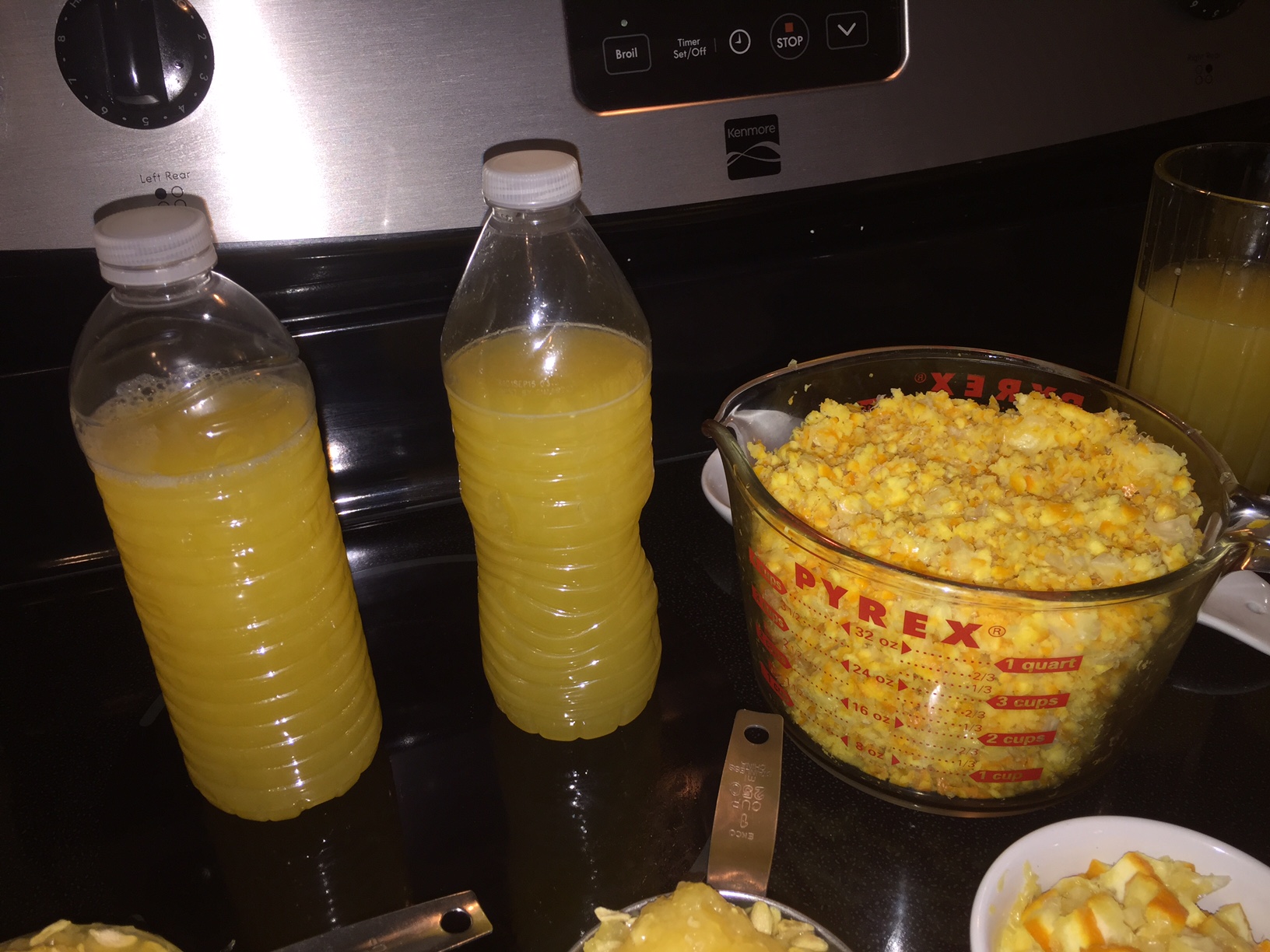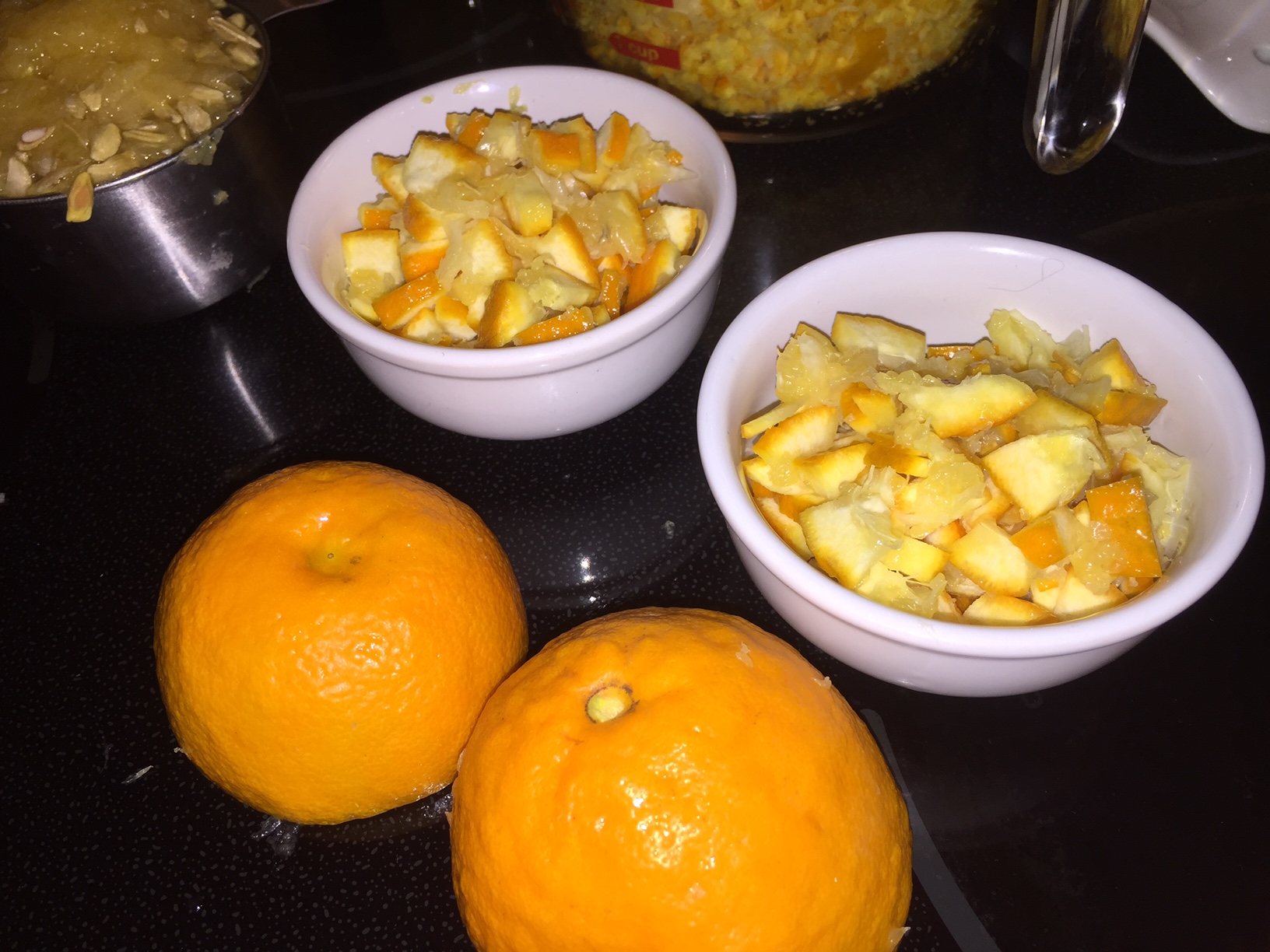4 Jar – Overview
This recipe makes enough marmalade to last you for a couple of months. If you want enough marmalade to last you through to next season, CLICK HERE for the amounts used to make a larger batch.
Marmalade is traditionally made with Seville oranges (also called sour oranges) which are FAR too sour to eat. They do, however, have a high amount of pectin in them. With the proper amount of sugar, this makes a great marmalade base to which other fruits can be added. Prep your oranges the day before, so they can soak overnight. Total hand-on time for this recipe is 3 – 4 hours, so make sure that you allow yourself enough time to cook safely.
PREPARATION
- Wash one lemon and 3 Seville oranges thoroughly.
- Peel the orange skin using a peeler. Don’t peel too deeply, you do not want the white (pith) which tends to be bitter. The orange peel will remain in the marmalade after cooking.
- Cut apart, discarding any bad spots
- Separate the innards and pith from the outermost orange peel. Keep the innards and tie them into a cheesecloth bag. This is where most of your pectin lives.
OVERNIGHT SOAK
- Pulse pith, pips and guts in food processor
- Place 2/3 C pips, guts, seeds, membrane innards into 1+1/3 C of water
- Pulse peel in food processor – only briefly
- Place 2/3 C peel into a second bowl containing 1+1/3 C of water
You should put the cut up and pulsed skin and innards into bowls covered with water overnight in the refrigerator. This will soften them so that the pectin is more easily released.
FIRST BOIL (90 MINUTES)
- Strain innards, pouring the soaking water into your stock pot
- Put innards into a cheesecloth – a bouquet garni – and secure with a string, keeping the end available for easy removal.
- Pour water and peel into your stock pot
- Add 1/3 C orange juice into your stock pot
- Bring up to boil, then reduce heat to simmer
- Skim foam as necessary. Stir with a WOODEN spoon. Metal will react with the acids in the orange
- Simmer for 90-120 minutes over low heat – this will release much of the pectin
If the oranges have not been soaked for at least 8 hours, go ahead and simmer for 120 minutes.
The seeds contains the pectin, and will be discarded after about 90 minutes. The outer orange peel will become the meat of the marmalade. I prefer to dice half and mince half of the rind, so that you have a variety of sizes of orange rind in your marmalade.
Definition: bouquet garni – A bag (frequently in a cheesecloth) that is used for infusions, and removed later as the recipe progresses. CLICK HERE to read more.
NOTE: DO NOT ADD SUGAR YET. If you add sugar too early, it will freeze the production of pectin, and your jam may not set properly, so don’t add it until after the 90 minute boil.
SECOND BOIL (HEAT TO 221º F – 105º C )
- Remove pips and pith in the mesh bag at 208º. Use a tongs to squeeze the juices from the bag back into the pot. Discard the bag.
- Increase heat and stir to dissolve. If sugar is added too soon, peel may become tough. Wait until temperature reads at least 210º
- BRING HEAT UP TO 210º BEFORE ADDING SUGAR
- 1 1/4 C granulated sugar
- 2 TBL Karo Syrup
- 1 TBL lemon juice
- Add the Second Boil ingredients slowly, stirring continually
- As soon as it starts boiling, stop stirring. Stir very infrequently.
- IMPORTANT NOTE: Until most of the water boils away, the sugar may stay at 215º for about 10 minutes. Once it hits 216º it will increase about one degree per three minutes.
- Keep heating until the temperature reaches 221º This could take up to an hour. I’ve had success with 119º but only marginally. Be patient and wait until it reaches full jell temperature. A few minutes will make all the difference. If possible, use a calibrated thermometer (or a scientific thermapen) to make sure your thermometer is not off by 2-3 degrees.
- Meanwhile, sterilize canning jars. Details not included on this page.
- When 221º is reached, remove the pot from the heat and let rest for 5-10 minutes. Skim off any scum or foam.
- Orange rind will rise to the top. Stir the rind back into the mixture before canning.
- Put into canning jars and cover with a lid put into hot water for at least 60 seconds. When properly canned and cooled, this will last you for about a year.
NOTE:
Temperature will plateau at 215 for quite awhile – for as long as 15 minutes
After that, you will get 1º increase in temperature about every 3 minutes
Be patient.
MORE INFORMATION
Alternative Recipes
There are SWEET ORANGE marmalades which do not use as much sugar as this recipe. CLICK HERE for Alton Brown’s recipe for Sweet Orange Marmalade, or USE THIS LINK for Strawberry Marmalade.
A Word of Caution
A word about POT SIZE. The first time I made this I nearly boiled over. It was a constant battle between foam and the size of my pot. This will foam up about 400% of its size. NO KIDDING. Make sure you use a pot large enough, or you will end up with a huge dangerous mess. This does not ALWAYS happen, but you can be prepared if it does.
I reuse my canning lids. If they fail to seal, I eat that jar first. Put an X on the failed lid so you don’t save it after the jar is empty. If they seal, they will generally not fail after cooling. I prefer to use the small canning jars, because once exposed to light and air, the marmalade starts to lose its flavor.
The canned jars will last longer if you process them in a water bath for 10 minutes after putting into jars.
-
-
-
- Put marmalade into sterilized canning jars
- Soak lids about 60 seconds in boiling water
- Wipe rim clean and put lids on
- Tighten only finger tight
- Submerge in water (1″ over top) and process 10 minutes
- Cool (undisturbed) on the counter
-
-
What is shown in the photos are quantities to make two entire large batches of marmalade.
Optional Ingredients
Optional ingredients reserved for the very end:
Minced strawberries, blueberries, rhubarb, shredded carrot, or other contrast
Chemistry
If you do not use enough sugar, the liquid will be unable to reach 221º (as water only gets 212º) and it will NEVER set. Sugar can get up to 300º If you try to decrease the calories, and use a marginal amount of sugar, you may heat it too long and you will get inverted sugar which has a longer shelf life, but is similar to high fructose corn syrup and is not as good for you as regular sugar.
Realistically, if you don’t have a thermometer, you can test the gel level but putting glass plates in the fridge, and then dripping jam onto the plate to see if it runs or just sits there. CLICK HERE
- If desired, after the temperature has reached 221º you can mix in some contrast fruit such as minced strawberry – but something that is ready to eat just as it is. Don’t use anything that needs cooking or softening.
- Pour into canning jars. If you completely can the marmalade, it should last for up to a year. Otherwise, refrigerate it for up to six months. I personally just put them on my shelf for up to a year, but if you do this, proceed at your own risk.
If your marmalade does not set, it is still good for steamed marmalade pudding, marmalade tarts, marmalade ice cream and much more. CLICK HERE if your marmalade did not set properly.
Bottom right: Some of your oranges may be older and nubbly. You will need juice from many oranges, but the peel that you want to use is from about eight oranges that have fairly smooth skin.
Top right: To get the amount of pips and pith that you need for the larger sized recipe, you will have to juice a lot more than eight, but just throw the extras into the trash.
 The ingredients freeze really well. Hot pack canning is another good option. If you freeze, be sure to leave an inch of headroom in your water bottles.
The ingredients freeze really well. Hot pack canning is another good option. If you freeze, be sure to leave an inch of headroom in your water bottles.
This photo gives you a good close up of the smoother skinned oranges and the older nubbly ones. The juice from the older oranges is perfectly usable, but the skin will be a bit more bitter than the younger oranges, so get rid of them.
I prefer just a few larger dices of orange, but most of the skin that I use is minced in a food processor.
Another good way to do it is with a zester. It takes more oranges, but you can leave the white pith behind, which actually gives you a better end product.


